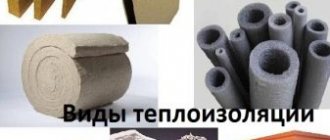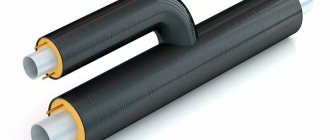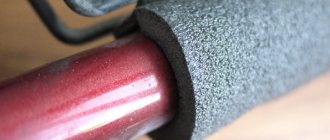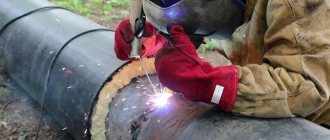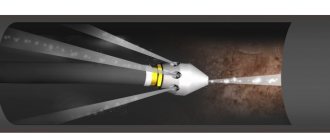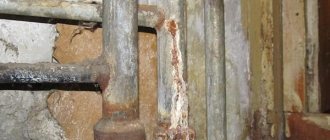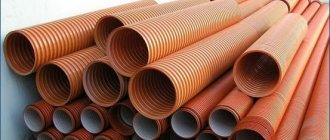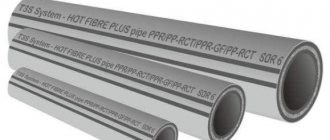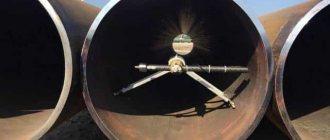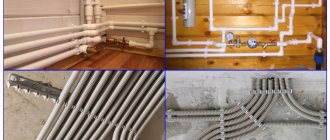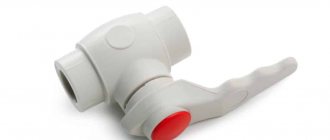The vast majority of regions of our country are characterized by very harsh winters. Frosts of minus 20 degrees and below will not surprise anyone. And even in the southern regions, with a mild climate, the weather sometimes brings “surprises” when the thermometer drops below zero for quite a long time. That is, at almost any point during private construction, you have to think about how to protect water supply lines from freezing.
Thermal insulation for water supply pipes
Frozen water in pipes is not only and not even so much a temporary loss of one of the communal “conveniences”. Most often, such troubles lead to literally catastrophic consequences - they end with the rupture of pipe walls, complete failure of the entire home water supply system, and the need for large-scale repair and restoration work. And hoping for some illusory luck, like this won’t happen to me, is extremely short-sighted. In any case, it is impossible to do without high-quality insulation of the system.
Let's see what kind of thermal insulation can be used for water supply pipes, let's look at the types of materials, their advantages and disadvantages. And with the main question - what should be the thickness of this insulating layer.
Main types of pipe insulation
I would like to immediately note that the most effective will be timely insulation, which is best done immediately at the time of laying the pipeline. Many people consider it sufficient to bury pipes to a decent depth.
- However, as we have already said, this is not always possible due to the characteristics of the soil .
- Secondly, if you plan to carry out the work yourself , then you will inevitably face a very long and labor-intensive process . It is advisable to dig deep trenches if you have special equipment at your disposal to make this task easier.
- And thirdly, if you are faced with the need to perform local repairs or replace a damaged pipe segment, this will be problematic due to the great depth .
Doing without insulation , especially now, when the range of thermal insulation materials is so wide, and simply relying on the fact that the climate will be favorable to you, is a rather reckless decision .
After all, it’s hard not to notice that lately the weather has been giving us surprises in the form of abnormal frosts or, conversely, abnormal heat. Depending on the type of materials used, insulation methods can be divided into three types:
- Reflective - when materials with an additional foil or aluminum layer , which reflect the cold from the environment and do not allow it to affect the surface of the pipe;
- Preventing heat loss - we are talking about materials that have a low coefficient of thermal conductivity , water and vapor permeability;
- Heating – when more modern methods are used, for example, a heating cable.
In this case, insulation occurs due to the heat generated by the heater. In order to minimize heat loss and direct it as much as possible to the heated pipe, it is additionally recommended to insulate with materials with a foil layer.
Glass wool
Those who have been involved in repair and construction work for a long time remember glass wool. It is still used at construction sites for both thermal insulation and sound insulation. The option, of course, is quite cheap, but do not forget that this material penetrates into clothing and then into the person himself, causing severe itching and painful sensations. Today, glass wool is sold in strips or slabs that are wound into a roll. It is for this reason that glass wool has gained particular popularity among builders.
Glass wool
It is worth adding that this insulation has a relatively low density, therefore, it is better not to use it without additional insulators. After the pipe is insulated, roofing material or fiberglass should be placed on top.
Return to content
Requirements for thermal insulation materials
Whatever type of insulation you choose, you will still have to face the challenge of choosing the right material. First you need to decide what qualities material should have that can really provide the desired result.
- The most important parameter is the value of its thermal conductivity coefficient . The lower this value, the better the thermal insulation will ultimately be;
- If we are talking about insulating the most vulnerable sections of the pipeline, namely those that run in open ground , it is necessary to select materials with high density and resistance to deformation . The soil layer exerts significant pressure on the surface of the pipe, and therefore the insulation. Moreover, the pressure value may vary depending on the amount and frequency of precipitation, average temperature and other indicators;
- An important condition is increased moisture resistance . Under the influence of moisture, which may be in excess in the surrounding soil, many insulation materials lose their insulating properties;
- Also, moisture in the soil can have a detrimental effect on the surface of the pipes, which over time will manifest itself as corrosion. Thermal insulation material, in addition to protection against freezing, additionally acts as a defense and from this undesirable phenomenon. Therefore its structure should be corrosion resistant;
- For plastic plumbing, fire safety is very important , which means the insulation must be fire-resistant ;
- The material must withstand high temperatures and not undergo deformation during sudden temperature changes;
- For economic benefit, it is better to choose insulation that can be reused ;
- The determining factor is the durability of the material . It will not always be economically profitable to purchase cheaper material in the future. It is better to spend a little more money and ensure reliable insulation that will last for several decades than to regularly replace the insulation simply because it has lost its properties. Not to mention that this would require digging up trenches and then re-burying them.
Mineral wool for pipe insulation
Thermal insulation using varieties of mineral wool has become widespread due to its affordable cost. With its help you can insulate heating pipes, hot water supply, water supply and sewer systems, as well as air ducts. This material works on the principle of a thermos. In addition, cotton wool protects the surface of the pipes from condensation . In the case of insulation of an underground pipeline, it is imperative to provide additional protection from moisture, so when wet, cotton wool loses its protective properties , and heat loss, in turn, increases. Mineral wool is a fibrous material for the production of which various raw materials are used. The most commonly used types are:
- Glass wool – made from the same raw materials that are used to make glass. Its fibers are quite thick. For convenience, glass wool is available in the form of slabs, rolls or shells. To protect against moisture, one side can be covered with foil or a thin layer of aluminum. The thermal conductivity coefficient is 0.030-0.052 W/m*K. The material belongs to the NG class - non-flammable. When installing glass wool, you must be extremely careful and take care of personal protective equipment. Because with any touch to the material, small sharp particles fly in different directions, which dig into the skin even through fabric gloves. It is especially important to protect the organs of vision and breathing, since particles entering the lungs cause severe and prolonged swelling;
- Basalt cotton wool - made from molten rocks. It weighs more than glass wool. The material is also non-flammable and able to withstand exposure to very high temperatures – up to 870°С. Index thermal conductivity more shortthan the previous variety and is 0.035-0.039 W/m*K. Differs more high density and hardness. In this regard, the release form can be either in the form of plates or in the form of cylinders. Additional foil layer can be implemented on both forms;
- Slag wool – made from waste from iron production. For pipe insulation use enough rarely.
This is explained by the increased friability and acidity of the material, on the surface of which oxides form over time, negatively affecting the surface of the pipes . In addition, the material cannot be classified as environmentally friendly. And its thermal conductivity is quite high for a thermal insulation material - 0.46-0.48 W/m*K .
Protection of insulation from negative factors
Thermally insulated water supply pipes laid in the ground are exposed to various factors that can destroy the protective coating. Since re-application of insulator or restoration of sections of the thermal insulation layer leads to additional costs.
It is therefore necessary to provide additional protection for highways. Some water pipe insulation materials do not require protection. For example: heat-insulating paint - it is not susceptible to external influences and is not damaged by rodents or insects.
Destructive effects of earth and water
An insulated pipe located deep in the soil is under constant pressure from the soil mass. The protective elastic layer is deformed, which changes the physical characteristics of the material for the worse. Before insulating a water pipe above ground, it is necessary to install an external protective screen (for example, from old pipes of larger diameter or using trays made of concrete or impact-resistant plastic).
Mineral insulation materials are hygroscopic and absorb moisture from the soil, which negatively affects the protection parameters. To prevent contact with the ground, the technology of laying water mains with an insulator through an auxiliary pipe of larger diameter is used.
The external screen provides protection from water and soil pressure. Waterproofing is allowed using sheets of roofing felt, thick polyethylene film or aluminum foil. The wound material is fixed with clamps, wire or plumbing tape.
Solving the problem of insects and rodents
If basalt wool was used to insulate a water pipe on the street or in the ground at a depth of up to 2000 mm. It is necessary to provide protection from rodents.
The surface is wrapped in a fine-mesh steel mesh, and an additional aluminum foil screen is used to prevent damage to the insulator by insects (for example, earth ants). When using polyurethane foam, additional protection is not required, since the material is not damaged by insects and rodents.
Foam plastic for pipe insulation
This material is a fairly effective insulation material that is lightweight . This greatly simplifies the installation process. Due to sufficient rigidity and strength, the foam does not deform under soil pressure. The main form of production of polystyrene foam pipe insulation is cylinders. They consist of two halves, which are connected to each other by means of a tongue and groove.
This is not only very
convenient , but also completely eliminates the possibility of the formation of cold bridges . The most common types of foam are:
- Penoizol;
- Extruded polystyrene foam;
- Expanded polystyrene foam.
The above materials differ in their density . Depending on this, the thickness of the thermal insulation layer also changes, which can range from 20 to 100 mm or more .
The internal diameters of the foam cylinders are equal to the standard external diameters of water pipes , which allows them to be insulated, provided that they fall within the diameter range from 15 to 144 mm .
operating temperature range of the material is also sufficient - from -188 to +95°C . Foam shells are often used for noise and heat insulation not only of plumbing, but also of ventilation and air conditioning systems, sewerage and gas pipelines. By choosing one of the types of polystyrene foam as insulation, you can count on the following advantages:
- Minimal heat loss;
- Protection of pipes from corrosion ;
- Tightness of the heat-insulating layer;
- Possibility of reusable use;
- Opportunity use as additional insulation during insulation heating cable. Since there are varieties of cylinders with special groove for cable routing;
- Resistance to the chemical effects of salts, lime and acids that may be present in the soil, as well as to the vital processes of various microorganisms;
- Durability;
- Resistance to sudden temperature changes ;
- Possibility to choose a protective shell even for fittings connections due to the presence of shaped parts.
Among the disadvantages , one can note increased sensitivity to solvents such as gasoline, acetone, and nitro paint.
Under their influence, the material simply melts.
Electric cable
It is worth mentioning separately about the electrical cable. It allows you to insulate a water pipe so that it does not freeze, above the ground and in the ground. The cable is distinguished by the fact that it is able to turn on independently at a temperature of +3 degrees and turn off independently when the temperature drops. But subject to installing a thermal relay. Otherwise, the self-regulating cable will draw a lot of electricity.
Electric insulation is especially good for regions with harsh winters or for those areas where rocky terrain does not allow pipes to be laid below the ground freezing level.
Interesting: DIY plumbing in a private house
Foamed polyethylene
Many experts note that among the variety of thermal insulation materials, it is polyethylene varieties that are the most optimal in terms of price/quality ratio. The structure of polyethylene consists of many closed cells, inside of which there is air, which, as is known, has the lowest thermal conductivity coefficient - only 0.024 W/m*K. There are:
- cross-linked (FPPE or HPPE) polyethylene foam, which is obtained by foaming the molten composition;
- non-crosslinked (NPE) polyethylene foam, for the production of which an extruder is used.
The structure of NPE is long linear molecules, between which there is no chemical bond. While cross-linked polyethylene has a denser consisting of smaller cells , with a stable molecular bond. You can even distinguish these two varieties visually.
Depending on the production method, the technical characteristics differ .
- Cross-linked polyethylene will have a lower thermal conductivity and higher density , making it resistant to deformation. But its cost higher than unstitched. Density ranges from 25 to 40 kg/m3 ;
- The material has increased elasticity , which is maintained even at low temperatures (-80°C) . This makes installation much easier;
- With a force of 5000 N/m2. the compression ratio of polyethylene is only 0.2;
- Due to the minimum value of the vapor permeability , which is 0.001 mg/m*h*Pa, the material can be classified as completely vapor-proof ;
- Coefficient of thermal conductivity amounts to 0.035 W/m*K;
- Polyethylene also has a low water absorption rate . When the material is immersed in water for a day, it absorbs no more than 0.5% of moisture from its volume. Moreover, upon reaching the figure of 1.9% after more time, water absorption stops increasing;
- The flammability class of the material is G2 ( moderately flammable );
- Moreover, in the event of inflammation, the material does not release substances to the body ;
- The structure of the material is not susceptible to the effects of various chemical elements .
- Polyethylene may have release form in the form of hollow cylinders with a technical slot along the entire length, sheets and rolls.
The material may have an additional protective layer of foil .
Polyurethane foam (PPU)
This material is no less effective insulation. To insulate the pipes, a polyurethane foam shell is used , which is a cylinder. It is made in two ways:
- By pouring liquid polyurethane under high pressure into a special mold:
- Manufactured using the “pipe in pipe” method . In this case, the material is poured into the cavity between two pipes - the inner one, with a smaller diameter, and the outer one, with a larger diameter.
The first option is suitable for yourself . And the product of the second production method is pre-insulated pipes ready for laying a new pipeline .
- This is a completely new product that makes it possible not to think about additional insulation ;
- In this case, the outer layer can be corrugated - flexible, which makes it possible to avoid the need to use rotary fittings , that is, the pipeline can be laid with a minimum number of connections;
- Both one- and two-pipe versions of such ready-made elements are produced;
- For laying cold pipeline designs are better suited with plastic pipes;
- For hot dishes, they produce more expensive options with metal pipes inside;
- Flexible pipes with pre-insulation are supplied in coils and have a length of up to 200 meters .
Regarding PU shell , it has the following advantages:
- Heat loss is reduced by almost 40% ;
- Installation of the elements is so simple that it allows you to independently insulate several hundred meters of pipeline in a day;
- This also indicates the speed of installation;
- The material is environmentally friendly ;
- The insulation can be reused an unlimited number of times;
- Term operation reaches 30 years.
Among the disadvantages is the impossibility of using the material at temperatures above 120°C . A great convenience is the presence of shaped segments, such as tees, elbows and branches. The connection of two shell fragments to each other occurs using a special coupling , which makes the thermal insulation airtight and prevents the possibility of the formation of cold bridges.
The shell also
differs in the material of its outer covering, which determines its scope of application. The coating can protect both from environmental factors, such as ultraviolet radiation, and from mechanical influences.
- Uncoated polyurethane foam is the most affordable, but can only be used for insulating pipes located, for example, in the basement, and then only if there is an additional casing . Either as an intermediate insulating layer;
- Shell with foil coating - the scope of application is not limited, and the material is characterized by increased strength ;
- Shells coated with fiberglass can be used to insulate external sections of the pipeline, for example, places where pipes enter the house. It is distinguished by its resistance to ultraviolet radiation . At the same time, fiberglass is also distinguished by high hardness , which virtually eliminates the possibility of mechanical damage ;
- The glassine coating is resistant to direct sunlight, but is inferior to fiberglass in strength;
- Shell coated with reinforced aluminum foil (armofol) - used for insulation of pipelines operated under conditions of significant temperature changes ;
- Galvanized steel coating is used to insulate pipelines running in air . Steel protects the shell from ultraviolet radiation, mechanical and biological influences, but at the same time is more affordable than a fiberglass coating.
The thickness of the shell is 20-80 mm and increases with increasing diameter. The length of one element does not exceed 1 meter , taking into account the peculiarities of the manufacturing process.
Heating of external water supply systems
To supply water, mains can be used, partially located above the ground or in an unheated basement. In this case, the home owner needs to know how to insulate the water pipe on the street. For protection, special material is used or heat is supplied from external sources (for example, from an electrical network).
Organization of water circulation
To increase the temperature of the water in the pipe on the ground surface, the technology of supplying small portions of liquid to the supply tank is used. For example, water from a well in winter has a temperature within 7-10 ° C; periodic activation of the pump is used to pump portions of liquid (manually or based on signals from a sensor installed in the pipeline).
Water enters the supply tank or is drained back into the well. But if the lines are made of steel pipes. Periodic drainage of the water supply leads to corrosion of the metal.
There is a technology for protection using excess pressure that is created by the pump. A pump with a check valve supplies water from the well to a storage tank designed for high pressure. The liquid is injected into a section of the pipeline located on the ground surface.
A pressure regulator is installed in the main line, which does not allow water to be supplied under excess pressure to the water supply network located inside the house. Due to the increased pressure, it is possible to reduce the crystallization temperature of water by several degrees.
Using the Electrical Cable
To increase the temperature of the pipelines, an electric cable located inside or on the outer surface of the pipeline can be used. The internal cable increases the efficiency of the heating system, but is difficult to install. The external cord is attached to the surface of the water supply using aluminum tape, which provides additional thermal insulation.
An adjustable thermostat is introduced into the circuit, allowing you to maintain the temperature in a given range while simultaneously reducing the load on the electrical network. Insulation of the water supply at the entrance to the house can be done with a self-regulating cable.
If the cord is correctly selected, installation of an additional controller is not required. The owner of the premises can independently assemble an electric heating line or use a ready-made solution.
Application of warm air
For heating with heated air, technologies with natural and forced ventilation of trays in which water mains are laid are used. The natural circulation technique involves installing an outer shell, which is then covered with an insulator.
The screen is placed in a heated room (for example, the technical floor of a residential building), hot air enters as a result of convection. The technique is used in residential buildings that are in constant use and equipped with heating systems.
The forced air blowing system involves installing 2 boxes along the main line into which hot air is pumped. The channels fit tightly to the surface of the pipeline; it is recommended to seal the joints.
The resulting structure is covered with a layer of insulator and installed in a protective pipe. Hot air is supplied by a fan with an electric heating element; it is possible to install a control unit with temperature sensors.
Foamed rubber for pipeline insulation
This material is made from natural or synthetic rubber and is classified as a material with increased elasticity. At the same time, high tear resistance . The structure of rubber is 90% closed cells. This allowed us to achieve the following positive characteristics:
- The thermal conductivity coefficient is 0.024-0.038 W/m*K and directly depends on the ambient temperature. The highest indicator is observed at 0…+20°С ;
- The material has excellent anti-corrosion properties;
- Shows resistance to substances such as gasoline and oil ;
- Has a low coefficient of water absorption and vapor permeability;
- operating temperature range is quite wide - from -200 to +150°C ;
- Under conditions of sudden temperature changes, it retains its properties unchanged ;
- In addition to reliable thermal insulation, it also provides high noise insulation ;
- Can be reused ;
- Is durable ;
The form of release of foamed rubber is sheets or hollow cylinders with a technical slot equipped with an adhesive layer. thickness is 6-32 mm , and the internal diameter is designed for pipes with a diameter of 6 to 114 mm .
Installation of shells made of basalt or expanded polystyrene
Insulation for water pipes made of basalt or expanded polystyrene is installed using the following technology:
Advice! It is best to start installation from the flange connection.
- shell halves of the corresponding internal diameter are placed on the pipe, with an overlap of 10-20 cm relative to each other required;
- preliminary fastening can be done with tape;
- in places of pipe outlets, specially selected segments or segments cut from straight sections of the shell are used;
- for thermal insulation of street areas, roofing felt or foil insulation can be used as a protective material;
- final fastening to the pipe is carried out using the tightening method;
- If dismantling is necessary, it is carried out in the reverse order.
Heating electric cable
One of the most effective ways to ensure long-term protection of pipes from freezing is the use of a heating cable. The advantage of this solution is that installation can be done both on top of the pipe and inside it. It all depends on the condition of the pipeline and the diameter of the pipes. When choosing an internal installation method, keep in mind that the cable may reduce the permeability of the pipes if their diameter is too small. The recommended minimum pipe internal diameter size is 40 mm. The heating cable itself can be of two types:
- Resistive;
- Self-regulating.
The latter type is more advanced, convenient and cost-effective. Its cost exceeds the cost of a resistive cable.
However, given that the finished heating system can operate almost completely without human intervention and requires minimal attention, it can be argued that the expense is justified.
A more complete description of both types of heating cable and the features of its selection and installation can be found in our article by following this link.
Liquid thermal insulation for pipelines
A completely new method of insulation is the use of special coloring compounds. Even a thin layer of such paint can replace 10-20 mm thick insulation . And if you apply the composition in several layers, you can achieve much better results. Heat loss can be reduced by up to 40% , while the coating does not allow water and moisture to pass through, but remains “breathable”. Liquid insulation is classified as energy-saving thermal paint and can be of two types:
- Ceramic , its consistency really resembles ordinary paint;
- As foam structure, which is applied to the desired surface by spraying.
The coating works on the principle of a thermos . The layer of material required for thermal insulation is very thin - only 0.5 mm . The advantages of this method of insulation include:
- When using the composition in the form of paint, its application simple and can be done with a regular brush ;
- If the coating chips or scratches form on it, it can be easily restored ;
- Low thermal conductivity;
- High elasticity , which allows the coating not to crack when the pipe diameter expands and contracts;
- Long service life;
- Health safety
- Condensation and corrosion do not form on the surface ;
- Possibility of application to surfaces of any configuration.
The disadvantages include:
- High cost of the composition;
- a foam composition as insulation , you will need to seek help from specialists . Which, as you know, provide their services only for large volumes of work. If you want to spray just a few meters of pipeline, you may simply not find a contractor.
High pressure thermal insulation
As a method of insulating a pipeline in a private house or country house, one can consider creating and maintaining high pressure in it. How it's done:
- to embed a receiver into the finished pipeline , which will have to create the necessary pressure - 3-5 atmospheres is quite enough;
- It is also necessary to additionally use submersible pump, to create pressure from 5 to 7 atm.;
- After the pump, a check valve and a tap are installed in front of the receiver;
- To start the system, you need to close the tap in front of the receiver and turn on the pump;
- The resulting pressure must be maintained in the system continuously until it is in use;
- To allow the pipeline to function again, you simply need to bleed off the excess air.
Conclusions and useful video on the topic
Heat shields and heating systems prevent water in pipes from freezing in winter, maintaining normal water supply to a country house or cottage. Factory-produced insulation materials are manufactured to fit the pipe sizes, making DIY installation easy.
If the owner of the house does not know how to insulate the water supply in an unheated room, then it is recommended to watch videos that describe the advantages and disadvantages of the technologies and provide a sequence of actions when installing insulators.
Air insulation
Understanding the characteristics of soil freezing in winter, you can use the thermal insulation method, when warm air from the bowels of the earth is used to heat the pipe. As you know, the soil freezes from top to bottom, while heat continues to flow from below. When insulating shells are used, this heat is simply cut off and not used.
To
save on the amount of insulation materials, you can create a structure that will resemble an umbrella . And work on the same principle. The cold from above will be insulated , and the heat coming from below will be concentrated at the depth of the pipeline.
This can be done using a flexible material with low thermal conductivity, which is laid in an arc over the pipe in a trench and then simply covered with soil. Additionally, you can fill the free space around the pipe with expanded clay. The article was written for the site.
Tags:Pipes
Rules for the construction of underground water supply
Basic documents used when developing an underground water supply scheme in a country house or in a residential building:
- SP 31.13330.2012;
- SP 22.13330.2011;
- SP 25.13330.2012.
Basic provisions of regulatory documents
Basic provisions of regulatory documentation:
- When laying pipes, it is necessary to take into account the depth of soil freezing; SP 31.13330.2012 standards recommend laying the pipe in the ground 500 mm lower than the point with a temperature of 0°C. The depth is determined experimentally or according to collected statistics; a calculated determination of the parameter is allowed.
- When calculating the freezing depth, the requirements of SP 22.13330.2011 are taken into account, which stipulate correction factors for various types of soil.
- In mountainous areas or when an estimated freezing depth of more than 2.5 m is obtained, additional calculations are carried out in accordance with Appendix G to the standards SP 25.13330.2012.
- In areas with an average annual stable positive temperature, it is allowed to introduce a correction factor of 1.1, which reduces the depth of laying highways.
Low temperature protection
When building a house, it is impossible to lay the entire water supply line below the freezing point. For example, in the middle zone the soil cools to negative temperatures at a depth of 1300 mm, and in the northern regions - at around 2250-2500 mm.
To reduce the depth of the trench and reduce the cost of work, thermal insulation of pipes is introduced or heating devices from an external heat source are installed. The choice of thermal insulation for water supply pipes or heating method depends on the characteristics of the pumped liquid and climatic conditions.
